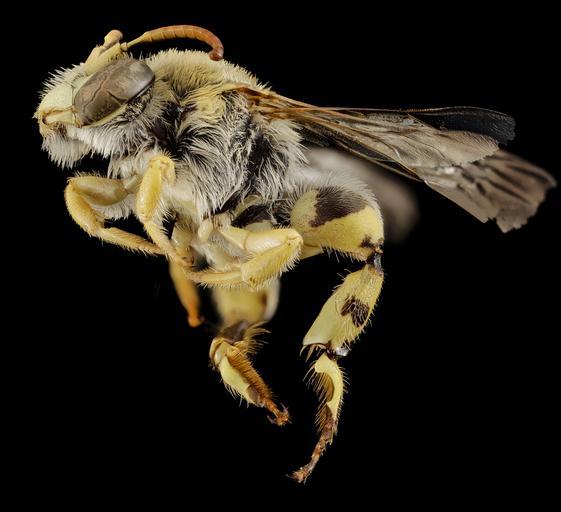MAKE A MEME
View Large Image

| View Original: | Meganomia_sp,_m,_south_africa,_side_2014-10-11-18.12.03_ZS_PMax.jpg (3631x3314) | |||
| Download: | Original | Medium | Small | Thumb |
| Courtesy of: | www.flickr.com | More Like This | ||
| Keywords: hymenoptera insecta apoidea melittidae taxonomy:binomial=meganomia binghami taxonomy:binomial=meganomiabinghami meganomia binghami meganomiabinghami south africa southafrica africa giant antenna male animal black background Meganomia binghami, Bingham’s Giant, collected in South Africa by Bryan Danforth Males of many species of bee have various modifications that are not found in the females and are presumably sexually selected – they arose because the females preferred males with, rather than those without, these strange features. Bingham’s Giant, like its close relatives, has males with numerous exorbitant modifications of the legs and underside – the parts that will be in contact with the female during mating. There are strange protrusions on the legs and undersurface of the thorax as well as additional processes on the abdomen. This species also has a transverse comb of stiff black bristles on the abdomen, perhaps the female likes to have her hair brushed during mating . Bingham’s Giant is one of a small number of very large bees restricted to Africa and the Arabian Peninsula. All of them have dramatic yellow and black patterns. ~~~~~~~~~~{{{{{{0}}}}}}~~~~~~~~~~ All photographs are public domain, feel free to download and use as you wish. Photography Information: Canon Mark II 5D, Zerene Stacker, Stackshot Sled, 65mm Canon MP-E 1-5X macro lens, Twin Macro Flash in Styrofoam Cooler, F5.0, ISO 100, Shutter Speed 200 Further in Summer than the Birds Pathetic from the Grass A minor Nation celebrates Its unobtrusive Mass. No Ordinance be seen So gradual the Grace A pensive Custom it becomes Enlarging Loneliness. Antiquest felt at Noon When August burning low Arise this spectral Canticle Repose to typify Remit as yet no Grace No Furrow on the Glow Yet a Druidic Difference Enhances Nature now -- Emily Dickinson Want some Useful Links to the Techniques We Use? Well now here you go Citizen: Basic USGSBIML set up: www.youtube.com/watch?v=S-_yvIsucOY USGSBIML Photoshopping Technique: Note that we now have added using the burn tool at 50% opacity set to shadows to clean up the halos that bleed into the black background from "hot" color sections of the picture. www.youtube.com/watch?v=Bdmx_8zqvN4 PDF of Basic USGSBIML Photography Set Up: ftp://ftpext.usgs.gov/pub/er/md/laurel/Droege/How%20to%20Take%20MacroPhotographs%20of%20Insects%20BIML%20Lab2.pdf Google Hangout Demonstration of Techniques: plus.google.com/events/c5569losvskrv2nu606ltof8odo or www.youtube.com/watch?v=4c15neFttoU Excellent Technical Form on Stacking: www.photomacrography.net/ Contact information: Sam Droege sdroege@usgs.gov 301 497 5840 Meganomia binghami, Bingham’s Giant, collected in South Africa by Bryan Danforth Males of many species of bee have various modifications that are not found in the females and are presumably sexually selected – they arose because the females preferred males with, rather than those without, these strange features. Bingham’s Giant, like its close relatives, has males with numerous exorbitant modifications of the legs and underside – the parts that will be in contact with the female during mating. There are strange protrusions on the legs and undersurface of the thorax as well as additional processes on the abdomen. This species also has a transverse comb of stiff black bristles on the abdomen, perhaps the female likes to have her hair brushed during mating . Bingham’s Giant is one of a small number of very large bees restricted to Africa and the Arabian Peninsula. All of them have dramatic yellow and black patterns. ~~~~~~~~~~{{{{{{0}}}}}}~~~~~~~~~~ All photographs are public domain, feel free to download and use as you wish. Photography Information: Canon Mark II 5D, Zerene Stacker, Stackshot Sled, 65mm Canon MP-E 1-5X macro lens, Twin Macro Flash in Styrofoam Cooler, F5.0, ISO 100, Shutter Speed 200 Further in Summer than the Birds Pathetic from the Grass A minor Nation celebrates Its unobtrusive Mass. No Ordinance be seen So gradual the Grace A pensive Custom it becomes Enlarging Loneliness. Antiquest felt at Noon When August burning low Arise this spectral Canticle Repose to typify Remit as yet no Grace No Furrow on the Glow Yet a Druidic Difference Enhances Nature now -- Emily Dickinson Want some Useful Links to the Techniques We Use? Well now here you go Citizen: Basic USGSBIML set up: www.youtube.com/watch?v=S-_yvIsucOY USGSBIML Photoshopping Technique: Note that we now have added using the burn tool at 50% opacity set to shadows to clean up the halos that bleed into the black background from "hot" color sections of the picture. www.youtube.com/watch?v=Bdmx_8zqvN4 PDF of Basic USGSBIML Photography Set Up: ftp://ftpext.usgs.gov/pub/er/md/laurel/Droege/How%20to%20Take%20MacroPhotographs%20of%20Insects%20BIML%20Lab2.pdf Google Hangout Demonstration of Techniques: plus.google.com/events/c5569losvskrv2nu606ltof8odo or www.youtube.com/watch?v=4c15neFttoU Excellent Technical Form on Stacking: www.photomacrography.net/ Contact information: Sam Droege sdroege@usgs.gov 301 497 5840 | ||||